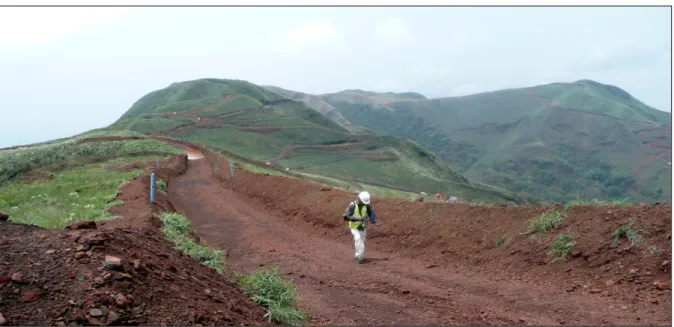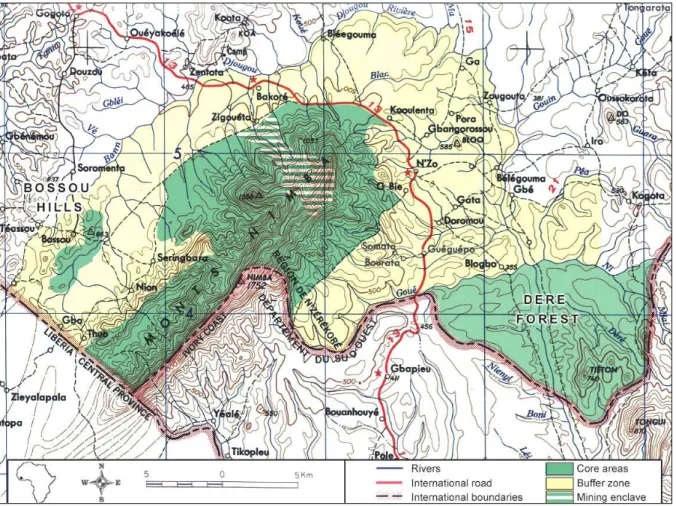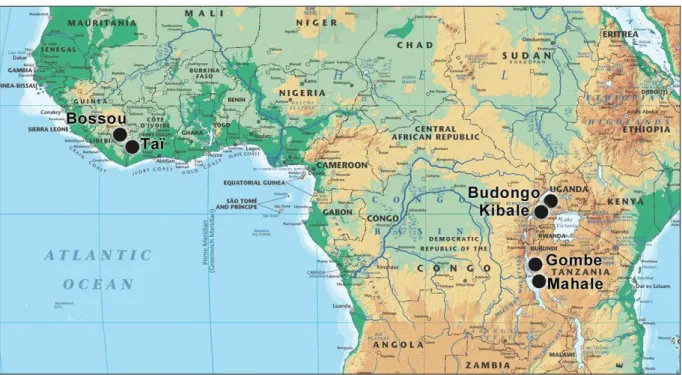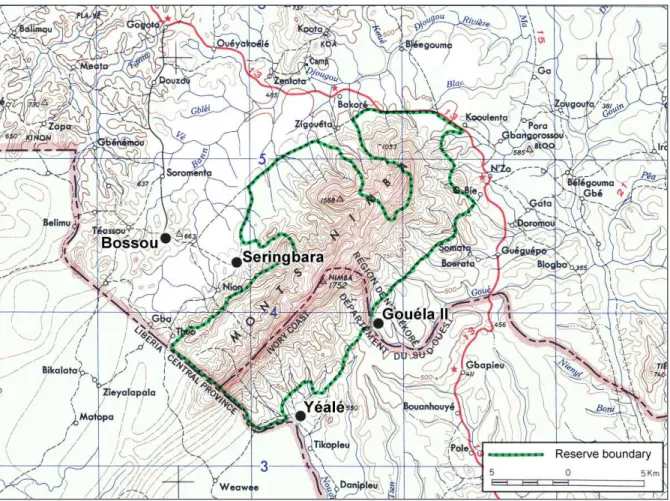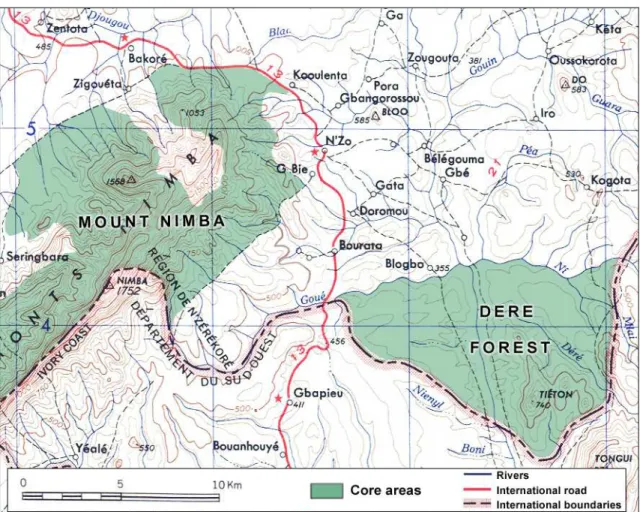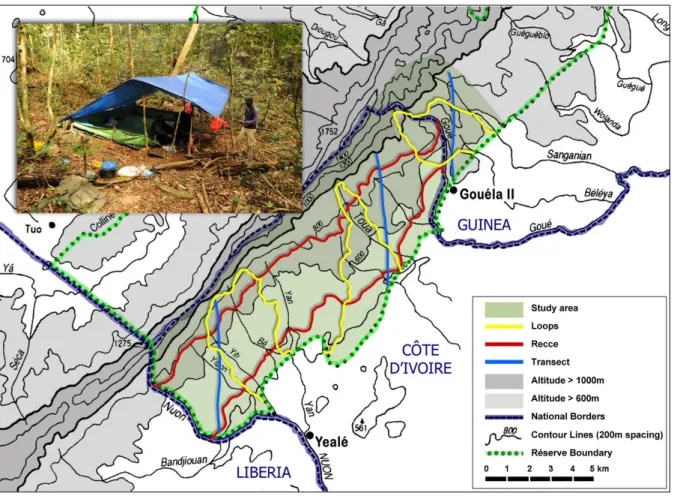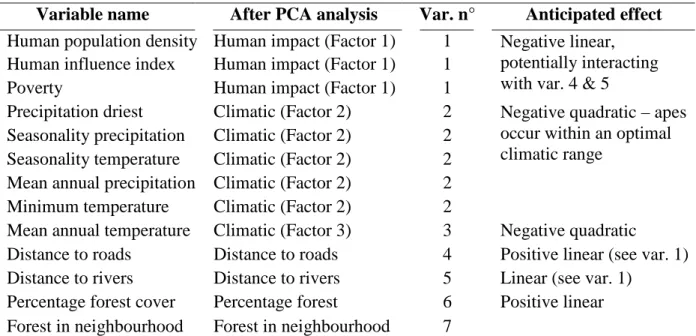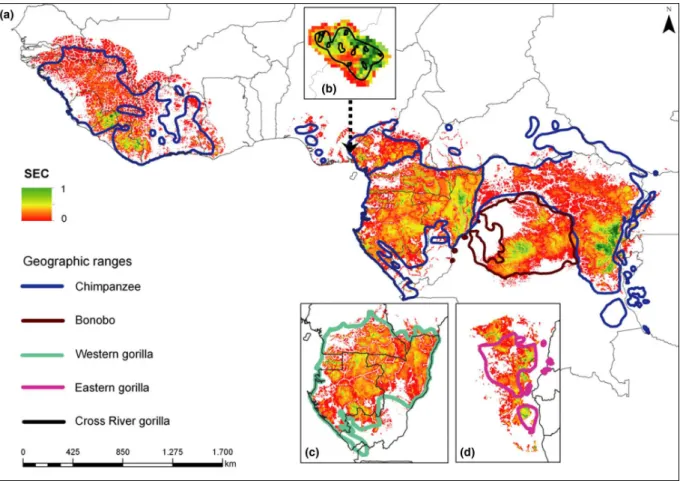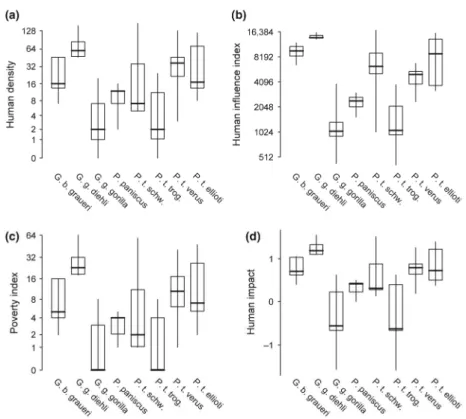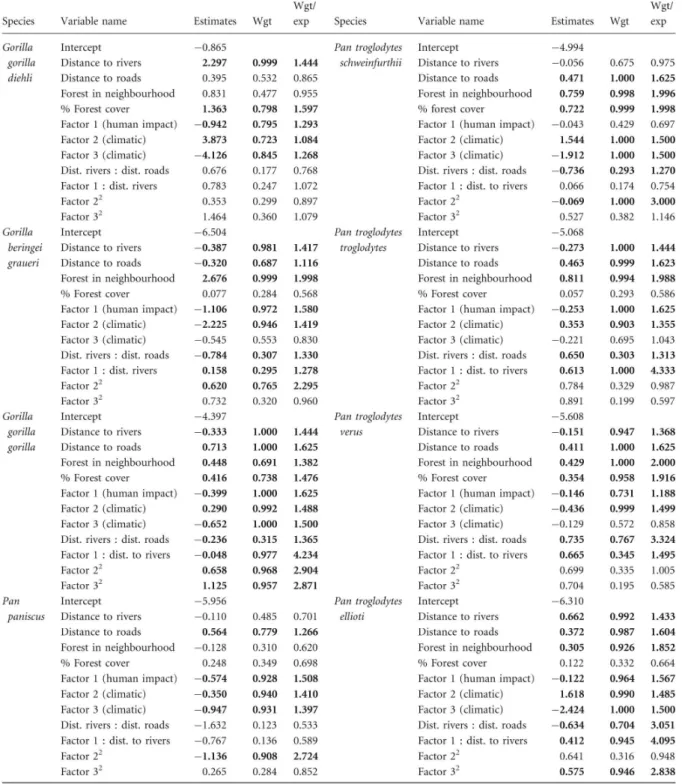FACULTY OF SCIENCES – UNIVERSITY OF LIEGE
Department of Biology, Ecology and Evolution Behavioral Biology Unit - Primatology Research Group
Ecology and Conservation of wild Chimpanzees Pan troglodytes verus
in the Nimba Mountain (Côte d’Ivoire and Guinea).
A dissertation submitted by Nicolas Granier with a view to obtaining the degree of Doctor of Science.
Dissertation advisor: Marie Claude HUYNEN (ULg, Liège)
Dissertation committee president:
Jean Pierre THOME (ULg, Liège)
Dissertation committee members:
Roseline BEUDELS (IRSNB, Brussel) Céline DEVOS (ULg, Liège)
Nikky TAGG (CRC, Antwerpen)
Régine VERCAUTEREN DRUBBLE (ULB, Brussel) Alain HAMBUCKERS (ULg, Liège)
ABSTRACT
Great ape populations have alarmingly declined across their ecological range in the course of the past decades. In Africa, chimpanzees and gorillas do not elude this menace, which today appears primarily due to the loss, degradation and fragmentation of suitable habitat. African apes are our closest living evolutionary relatives, flagship and umbrella species playing important roles in ecosystem services and showing a great diversity of behavioral and ecological adaptations, as well as important cultural variations. In order to efficiently protect them, and at the same time to ensure the sustainability of a series of naturally co-occurring wildlife species, it is crucial to understand their specific ecological requirements in each place where they are subsisting. In the biodiversity hotspot of the Guinean Forests of West Africa, the World Heritage site of Mount Nimba was established in 2003 as one of the 5 exceptionally important areas for the conservation of West African chimpanzees. This scenic relief stretching over the tri-national border between Guinea, Côte d’Ivoire and Liberia harbors a particularly rich biodiversity with high level of endemism.
Striving to meet the above-described conservation objective, the present study proposes a detailed investigation of basic traits of wild chimpanzees’ life history in the Nimba Mountain. Based on the results of preliminary surveys conducted in the eastern part of the Nimba Biosphere Reserve between 2006 and 2008, we established a 60 km2 study area in the middle of the massif’s southern slope, where chimpanzees were thought to permanently dwell. The central question was to understand why this population was apparently more frequently ranging in altitude habitat, particularly in the mountain forest of secondary vegetation type, and in places of high ground declivity. The formulated hypothesis was that this habitat type supplied food year-round to chimpanzees, while offering a reduced proximity to humans and a low probability of unforeseen encounter. To test this assumption, we monthly monitored 80
km of survey itineraries systematically set in the study area during 19 months between 2009 and 2011. We extensively described the structure and composition of habitat, the fruit phenology, seasonality and topography along these itineraries, while recording all signs of chimpanzee presence together with signs of other large mammals and human activity.
We used nest counts methods from line transect to estimate a population density that was included between 0.14 and 0.65 chimpanzee/km2. Chimpanzees were highly selective in their choice of nesting-tree and nesting-site. Logistic regression indeed showed their preference for nesting in gallery and mountain forests rather than lowland forest, and in old-growth forest rather than secondary forests, preferentially in steep locations. Poisson regression with all non-nest signs of chimpanzee presence revealed a marked preference for mountain and gallery forests of old secondary type, particularly when feeding. General availability of fruit food was highly seasonal in the study area, with a soaring fructification peak during 4 dry months (Jan-Apr) and a clear, consistently scarcer availability during the 7-month rainy season. However, the abundance of 45 principal fruit foods of Nimba chimpanzees showed aseasonal monthly fluctuations with an opposite tendency: it was relatively low during the dry months and showed 3 peaks of increase during the rainy season. A second logistic model showed that non-nest signs of chimpanzee presence were linked to the abundance of seasonal fleshy fruits during the rainy season and to the fruit abundance of plants with lowly seasonal fructification pattern during the dry months. Nauclea diderrichii and Grewia barombiensis seasonally produced fleshy fruits we proposed as preferred foods. Two plants of lowly seasonal fructification pattern (Solanum torvum, Rinorea oblongifolia) and Marantaceae stems, which attracted chimpanzees only during fruit food scarcity, were considered as filler fallback foods. Furthermore, we established Zingiberaceae stems and fruits, which were eaten every month and attracted apes across seasons, as a staple fallback resource. In addition, both logistic and Poisson models revealed greater chimpanzee activity in the study area during the dry season
(Dec-Apr), and year-round preference for altitude habitats (between 770 and 975 m altitude). Chimpanzees avoided habitats exploited by artiodactyls and humans, and obviously selected the same habitats as 7 other primate species described in the study area.
Plotting observations of chimpanzee nest groups and signs revealed a clear gap in the middle of the study area. In the lights of findings on the ranging and grouping patterns, this result suggests that the approximately 40 chimpanzees dwelling in the study area would divide into 2 distinct communities. The Nuon River marking the border between Côte d’Ivoire and Liberia would be part of the core area of one community, and the Goué River at the Guineo-Ivorian border would be in the peripheral zone of the second community.
Taken altogether, these findings lead to general conclusions on the status and basic ecological requirements of Nimba chimpanzees, which can readily be used to enhance purpose-built actions for their conservation. In a broader viewpoint, we show how ecological research conducted on populations of chimpanzees and Cercopithecus monkeys can efficiently contribute to the sustainable conservation of forested ecosystems in the Nimba region. As a conclusion, we propose a holistic and cohesive outlook on environmental conservation in the tri-national Nimba. We expose the key features of a purpose-built general management plan, and discuss the opportuneness and efficiency of the different conservation tools that have been used in this extremely rich and diverse region.
TABLE OF CONTENTS
FIGURE INDEX ………..…. xii
ACKNOWLEDGEMENTS ………... xiv
INTRODUCTION ……….. 1
I.1. The Mount Nimba …….……..………. 1
I.1.1. General presentation …...…….……… 1
I.1.1.1. Geomorphology and biogeography ……… 1
I.1.1.2. Biodiversity and endemism ……… 5
I.1.1.2.1. Flora ………... 5
I.1.1.2.2. Fauna ………. 8
I.1.2. Research and conservation ……….. 9
I.1.3. Human population and threats to biodiversity ……….….. 10
I.2. The chimpanzee ……….……. 14
I.2.1. Taxonomy ……….. 14
I.2.2. Long-term research sites ……… 15
I.2.3. Ecology and behavior ……… 16
I.2.3.1. Ranging and social ……… 16
I.2.3.2. Nesting ………..……… 19
I.2.3.3. Diet ……… 20
I.2.3.4 Tool use and culture ………... 20
I.2.4. Conservation ………...………... 22
I.3. Chimpanzee research in Bossou and Nimba ………..………….. 23
I.3.1. The chimpanzees of Bossou ……….. 23
I.3.2. History of chimpanzee research in Nimba: Seringbara, Gouéla II, Yealé …. 27 I.4. Building and implementing the present study ……….…. 29 I.4.1. Preliminary surveys in the eastern Nimba Mountain Biosphere Reserve ….. 29
I.4.2. New study area: Yealé – Gouéla II ………. 31
I.4.3. Aims of the core research in Nimba southern slope ………...… 32
I.4.4. Content ………... 34
CHAPTER I: Global issues and local perspectives of conservation ……… 37
II.1. Recent decline in suitable environmental conditions for African great apes .. 38
II.1.1. Abstract ……… 39
II.1.2. Introduction ……….…. 40
II.1.3. Methods ……… 43
II.1.3.1. Presence localities ……… 44
II.1.3.2. Predictor variables ……….….. 44
II.1.3.3. MAXENT analysis ……….……. 46
II.1.3.4. Absence localities ……… 46
II.1.3.5. SEC model ……….….. 48
II.1.3.6. Temporal change in SEC ……….… 48
II.1.4. Results ……….. 49
II.1.4.1. Current SEC distribution ………..………... 49
II.1.4.2. Recent decline in SEC ……….… 51
II.1.5. Discussion ……… 53
II.1.5.1. Species and regions ……….… 55
II.1.5.2. Model evaluation ……….… 57
II.1.5.3. Limitations of SEC model ………;….. 58
II.1.5.4. Fields of application ……… 60
II.1.6. Conclusion and outlook ……… 61
II.2. Conservation issues in the Nimba Mountain ……….…. 62
II.2.1. Abstract ……….…… 63
II.2.2. A tri-national biogeographical and anthropological entity ……….….. 63
II.2.2.1. Biogeomorphology ……….. 63
II.2.2.2. Cultural influences ……….. 66
II.2.3. Conservation keystones ……… 67
II.2.3.1. Conservation status of the Nimba Mountain ………... 67
II.2.3.2. Tri-national perspectives of conservation ………... 69
II.2.4. Contribution of scientific studies ……….… 71
II.2.4.1. History ………..……….….. 71
II.2.5. Threats to Nimba chimpanzees ……… 73
II.2.5.1. Anthropic pressures ………. 74
II.2.5.2. Mining and logging ………. 76
II.2.6. Toward integrated conservation ………... 77
CHAPTER II: Chimpanzees in the eastern part of the Nimba Mountain Biosphere Reserve: Gouéla II and Déré Forest ……….. 80
III.1. Abstract ………...… 81
III.2. The eastern part of the Nimba Mountains Biosphere Reserve ………... 81
III.2.1. Gouéla II ……….. 83
III.2.2. Déré Forest ……….…. 84
III.3. Chimpanzee research ……….… 85
III.3.1. History ……… 85
III.3.2. Present study ………... 86
III.3.2.1. Objectives ………. 86
III.3.2.2. Methods ………. 86
III.4. Preliminary results in Gouéla II ……… 88
III.4.1. Selective use of altitude forest and irregular presence ……….….. 88
III.4.2. Nesting behavior ……… 89
III.4.3. Tool-using behavior ……… 90
III.5. Preliminary results in Déré ……… 91
III.6. Perspectives on future chimpanzee research and conservation ………. 91
III.6.1. Research perspectives ………..……….. 91
III.6.2. Conservation perspectives ……….. 92
CHAPTER III: Density estimates and nesting-site selection in chimpanzees of the Nimba Mountain, Côte d’Ivoire and Guinea ……… 94
IV.1. Abstract ……….…. 96
IV.2. Introduction ……… 96
IV.3. Methods ……….…. 98
IV.3.1. Study site ……..……….……….. 98
IV.3.2. Data collection ……… 99
IV.3.3. Data analyses ……… 101
IV.4.3.1. Chimpanzee density estimates ……….… 101
IV.4.3.2. Nesting-tree selection ……….….. 103
IV.4.3.3. Nesting-site selection ……….….. 104
IV.4. Results ……….…. 106
IV.4.1. Sampling effort, vegetation structure and composition ……… 106
IV.4.2. Nests ……….…. 107
IV.4.3. Density estimates ……….…. 108
IV.4.4. Nesting-tree selection ……… 109
IV.4.5. Nesting-site selection ……… 111
IV.5. Discussion ……… 113
IV.5.1. Density estimates ……….. 114
IV.5.2. Nesting-tree selection ……… 115
IV.5.3. Nesting-site selection ……… 115
IV.5.4. General views on chimpanzee populations ……….…….. 116
IV.5.5. Conservation perspectives ……… 117
CHAPTER IV: Importance of secondary vegetation in feeding strategy and habitat selection of Nimba chimpanzees: implications for conservation .. 118
V.1. Abstract ………. 119 V.2. Introduction ………... 119 V.3. Methods ………. 122 V.3.1. Study site ……… 122 V.3.2. Data collection ……… 123 V.3.2.1. Survey itineraries ………... 123
V.3.2.2. Vegetation structure, fruit phenology, faunal and human presence ... 124
V.3.3. Data analysis ………..……… 125
V.3.3.1. Fruit abundance ……….… 125
V.3.3.2. Influence of fruit abundance and THV availability on chimpanzee presence ………... 127
V.3.3.3. Influence of habitat, fauna and human on chimpanzee signs counts .. 129
V.4. Results ………... 130
V.4.3. Influence of fruit abundance and THV availability on chimpanzee presence 133
V.4.4. Influence of habitat structure on chimpanzee signs counts ……… 134
V.4.5. Influence of other species on chimpanzee signs counts ………. 138
V.5. Discussion ………. 139
V.5.1. Seasonality and food availability ………... 139
V.5.2. Feeding strategy ………. 139
V.5.3. Preferred and fallback resources ………..……….. 140
V.5.4. Habitat selection ……….… 141
V.5.5. Chimpanzee communities in the Ivorian Nimba ………..….. 141
V.5.6. Research and conservation ……….… 142
DISCUSSION ……….. 143
VI.1. General views on the ecology of chimpanzees in the Ivorian Nimba ……… 144
VI.1.1. General methodological considerations ……… 145
VI.1.2. Habitat description ……… 146
VI.1.2.1. Vegetation ……… 146
VI.1.2.2. Fruit phenology ……… 148
VI.1.2.3. Temperature and humidity ……….….. 150
VI.1.3. Feeding strategy ……… 152
VI.1.3.1. Importance of secondary vegetation ………..…….…. 152
VI.1.3.2. Preferred and fallback foods ……… 154
VI.1.4. Nesting behavior ………..….… 158
VI.1.5. Abundance ……… 160
VI.1.6. General ranging patterns ………... 162
VI.1.7. Cultural variations ………. 165
VI.2. Conservation perspectives ……… 168
VI.2.1. General context and conservation issues ………...… 169
VI.2.2. Findings from Nimba chimpanzees ……….…. 170
VI.2.2.1. Tree species of particular interest for conservation ………. 170
VI.2.2.2. Importance of secondary vegetation and altitude habitats ..….…… 173
VI.2.2.3. Primates as umbrella species ……….... 175
VI.2.3. Global threats to chimpanzees ……….…. 177 VI.2.4. Holistic approach of biodiversity conservation: a chimpanzee perspective 178
VI.2.4.1. General measures ……….…… 179
VI.2.4.1.1. Subsistence activities of local people ………. 179
VI.2.4.1.2. Ecological monitoring ……… 179
VI.2.4.2. Mount Nimba ………... 181
VI.2.4.2.1. Mining mitigation ………...……… 181
VI.2.4.2.2. On the value of biodiversity sanctuaries ………. 183
VI.2.4.3. Bossou Hills and chimpanzee research ……… 184
VI.2.4.4. Déré Forest and mining offset ……….. 186
VI.2.5. Outlook on conservation strategies ………... 189
REFERENCES ……… 192
ANNEX 1: Appendix S1 (Chapter I.1.) ……… 219
ANNEX 2: Appendix S2 (Chapter I.1.) ……… 239
ANNEX 3: List of identified tree species in the Ivorian Nimba, with scientific and Yakuba names ………... 258
FIGURE INDEX
Fig: 1: The Nimba relief ………... 2
Fig. 2: Presentation of the Nimba Mountain ………. 4
Fig. 3: Secondary vegetation at the mountain forest edge ……… 7
Fig. 4: The Mount Nimba viviparous toad ……… 8
Fig. 5: Remains of the scientific station built in the 1940s ………...……….. 10
Fig. 6: Hunter with 4 monkeys, Central Africa ………..…………. 11
Fig. 7: Roads on the top of Nimba, in the mining enclave ………..… 12
Fig. 8: Map of the Nimba Mountain Biosphere Reserve ……… 13
Fig. 9: Young male adult chimpanzee ……… 15
Fig. 10: The 6 long-term research sites on chimpanzees in Equatorial Africa ……….….. 16
Fig. 11: Map of the chimpanzee ecological range ……….. 18
Fig. 12: Chimpanzee nests ……….. 19
Fig.13: Chimpanzee using a stick to expel food ………...….. 21
Fig.14: Bossou chimpanzees cracking-open nuts of Elaeis guineensis ……….…. 22
Fig. 15: Bossou village at the foothill of Mont Gban ……….… 24
Fig. 16: Leopard experiment ……….….…. 26
Fig. 17: Chimpanzee study sites in Nimba ……….…… 27
Fig. 18: The southern slope of the Nimba Mountain ..……….….…. 29
Fig. 19: Map Of the eastern part of NMBR ……….……... 30
Fig. 20: Map of survey itineraries in the study area ………..…. 33
Fig. 21: Predicted distribution of SEC for the 2000s ……….……. 50
Fig. 22: Values extracted for human density, human influence index, poverty index and human impact for all presence localities of great apes ……….... 51
Fig. 23: Percentage change in area and number of SEC between the 1990s and 2000s for all African ape taxa ……… 54
Fig. 24: Estimated decrease in SEC between the 1990s and 2000s ……… 56
Fig. 25: Map of the Nimba Mountain along the tri-national border between Guinea, Côte d’Ivoire and Liberia, West Africa ……….… 65
Fig. 26: Protected areas in the Nimba Mountain region ……….… 70
Fig. 27: The eastern part of the Nimba Mountain Biosphere Reserve ……….……... 82
Fig. 30: Study area and survey itineraries in the Nimba Mountain ……….…. 100
Fig. 31: Spatial distribution of nest groups ………... 107
Fig. 32: Preferred and avoided nesting-tree species ………. 109
Fig. 33: Preferred and avoided nesting-tree DBH ……… 110
Fig. 34: Variations of OR of continuous variables ……….….. 111
Fig. 35: Study area and survey itineraries in the Nimba Mountain ……….. 123
Fig. 36: Spatial distribution of chimpanzee signs and nest groups ……… 130
Fig. 37: Year-round patterns of fructification ………..……. 132
Fig. 38: Variations of altitude odds ratios for each category of chimpanzee signs ……… 136
Fig. 39: The Yan River, clear cut in altitude vegetation formation ...………...…… 147
Fig. 40: The southern slope of Nimba ……….….…. 149
Fig. 41: Temperature and humidity recorded at 450 and 800 m altitude ………….……. 151
Fig. 42: Identifying fruits eaten by Nimba chimpanzees ………..… 156
Fig. 43: Ground nest ………. 159
Fig. 44: Putative ranges of the 2 communities in the Ivorian Nimba ……….….. 164
Fig. 45 Nut-cracking in Bossou chimpanzees ……….….. 166
Fig. 46: The Zié valley ……….…. 170
Fig. 47: Old secondary forest ……….…... 174
Fig. 48: The mining enclave and the 3 proposed corridors ……….….. 182
Fig. 49: Bossou chimpanzees go to Liberia ………..… 185
Fig. 50: Green network for chimpanzees and large fauna ………... 187
ACKNOWLEDGEMENTS
A Jean, et à Stéphane
I first visited Bossou at the invitation of Professor Matsuzawa. In addition to Bossou chimpanzees, I discovered with great amazement the neighboring Nimba Mountain, where I had the luck to observe wild and non-habituated chimpanzees in the forest of Seringbara. The same year, I met Marie Claude Huynen in Guinea through David Brugière. After several experiences in natural resources management in West Africa, in 2005, thanks to these persons I started conducting field research on chimpanzees of the Nimba region as a PhD student of the University of Liège. In the course of the past years, I actually spent more time in West Africa, and particularly in the Nimba region, than anywhere else. I was living there, working with different persons in changing places. Guinea, and particularly the Nimba region became somehow my home of adoption. Thus, it is difficult to acknowledge everybody here, but I would like to start by thanking you, who are reading these lines, sincerely hoping it will provide you as much pleasure and enrichement as it did to me.
I express my sincere gratitude to professor Matsuzawa for his constant support, his trust and wise advices. He is the person who made this adventure possible, with Marie Claude Huynen
who welcomed me with lot of respect and open-minded experience. I also would like to thank Pascal Poncin, for accepting my unforeseeable presence during 9 years spent in the laboratory at the aquarium of Liège. Alain Hambuckers, of course, who joined the team more recently but was of an incommensurable help with all matters related to statistics and modeling. I also warmly thank all the students, researchers and workers of the behavioral biology unit, for their presence, reception and kindness, as well as the students, colleagues and researchers I met in Inuyama and Seoul during these years. I am really indebted to the numerous people who helped me designing, implementing, commenting and improving the present research. Finally, I am deeply grateful to all the jury members who kindly accepted to invest themselves in this work and to share their respective experiences.
There are even more people to acknowledge in Africa. I will start with all the Guinean and Ivorian authorities who accepted this research and my presence, and particularly the responsibles and workers of the Guinean ‘Direction Nationale de la Recherche Scientifique et de l’Innovation Technologique’ (DNRSIT) and of the ‘Institut de Recherche Environnementale de Bossou’ (IREB). I also sincerely thank the ‘Office Ivoirien des Parcs et Réserves’ in Côte d’Ivoire, for their valuable efforts in environemental conservation.
I am finally particularly grateful to all the villagers, the guides and field assistants, together with their families for their huge dedication and all the things they taught me on their countries, cultures, and amazing natural environment. Among others, thanks are due to some people of the N’Zo ‘sous-préfecture’: Jacques Bamba, Leonard Gamaleu, Mamadou Zogbélémou, Paul Molmou and especially Michel Lakpö Zogbélémou, for their indispensable help and dedication. I am also very obliged to all the villagers of Yealé who welcomed me during about 2 years between 2008 and 2011. I would like to tell them that beyond this work, living with them was a rich experience of friendship and sharing. I am particularly talking to the 7 Yealé persons who guided me throughout the forest and the village: David Droh,
Anatole Gogo, Philibert Pahon, Anthony Kpan, Alexis Wonseu, Pascal Gbian and Ferdinand Kehouwon.
This research was financially supported by grants from the Japanese Ministry of Education, Culture, Sports, Science and Technology, the Japanese Ministry of Environment (MEXT #16002001, #20002001, #24000001) and the Japanese Society for the Promotion of Science in the JSPS-ITP-HOPE, awarded to T. Matsuzawa. N. Granier also received a grant from IUCN/SSC Primate Specialist Group, Great Ape Emergency Conservation Action Fund, and a scholarship from the Japanese Society for the Promotion of Science.
I.1. The Mount Nimba
I.1.1. General presentation
I.1.1.1. Geomorphology and biogeography
The Mount Nimba is a 40 kilometers long wall, large of about 10 km, stretching in a northeastern-southwestern orientation at the tri-national border between Guinea, Côte d’Ivoire and Liberia. Rising abruptly more than 1,000 m above a surrounding plain covered by a ferruginous crust and culminating at 1,752 m, it is one of the highest West African mountains. Its steep slopes dug of deep and narrow valleys can exceed 75° inclination in some places, particularly in their higher part where they get steeper and delimit the sharpened ridge line of the massif (Fig. 1).
Fig. 1: The Nimba relief
The Nimba relief is a Precambrian formation of green schist based on a gneiss and granite bedrock, which has been formed from the folding of birrimian sediments (Leclerc et al. 1955). Its long and complex geological history has determined its harsh topography (Lamotte et Rougerie 1998) and the atypical presence on its top of emergent iron ore quartzite inlaid into a ferruginous mica-schist formation (Misra and Raucq 1986). The relatively large iron deposit (estimated to 600 millions tons), which is of very high quality (Fe 65%) and can be extracted by open-pit mining, has drawn the attention of mining industry for decades (Pascual 1988). Watercourses of the important and regularly developed hydrographic network draining the Nimba Mountain have shaped deep and steep ravines (Lamotte and Rougerie 1998). The numerous streams originating in the massif feed three main rivers ending up in the Atlantic Ocean: the Cavally, flowing southwards into Côte d’Ivoire; the Ya, flowing south-eastwards into Liberia; and the Nuon, flowing south into Liberia (Fig. 2).
The Nimba mountain chain is located at the crossroads of three climatic domains (equatorial-guinean, libero-guinean and sub-sudanian) and of two major tropical winds (the humid monsoon blowing from the Gulf of Guinea, and the dry and hot trade wind, or Harmattan, blowing from the Sahara; Lamotte 1998a). The climate of Nimba results therefore from a mixture of these 3 climatic influences, with each likely to be predominant depending upon years. Similarly, the seasons are determined by the labile balance between the influences of the monsoon, dominant during the rainy season, and of the Harmattan prevailing during the dry season. Altitude reinforces the influence of Harmattan during the dry season and of rainfalls during the rainy season, creating a greater inter-seasonal contrast between the crest and foothill (White 1986). Although these highly original climatic conditions and topography ruggedness cause important fluctuations in temperature and rainfall pattern across places, seasons and years, the Nimba region is globally subject to an alternation of a dry season lasting in average from December to April, and a rainy season from May to November
Fig 2: Presentation of the Nimba Mountain
In the up-right picture from Lamotte and Rougerie (1998), which has the same orientation than the map below, savannas appear in white both on the top of the mountain and in the plain, while forest is in black. Altitude savannas covering the top of the mountain northeastern half stop briefly at the level of the Yan River, in Côte d’Ivoire.
(Lamotte 1998). The Nimba relief brutally emerging more than 1,000 m over the surrounding bedrock forms a climatic barrier exposed to, and constraining airflows, which despite its relatively small size, provides remarkable additional diversity in landscape and local climates. Such a complex climatic diversity, added to the variety of the existing edaphic conditions, has led to differentiation of a wide variety of vegetation formations and ecological niches populated by a highly diverse fauna.
I.1.1.2. Biodiversity and endemism
Located in the range of Guineo-equatorial evergreen rainforest, the low part of Nimba slopes is wooded. In the northeastern half of the massif, which is the highest, this forest is found up to 800 – 900 m altitude. A thin and rocky soil covered of low herbaceous vegetation is found from 900 m altitude to the top, broken by stretches of gallery forest extending along ravines up to 1,600 m altitude. In the occidental half of Nimba, which is of lower altitude and more exposed to humid winds, slope forests join up on the ridge forming a continuous afforestation. The demarcation between presence and absence of altitude grasslands in the massif is clearly materialized at the level of the Yan River (Fig. 2).
I.1.1.2.1. Flora
Almost all vegetation types of the Guineo-Congolese regional center of endemism (White 1986) are represented in Nimba, which led Schnell (1998) to describe the mountain as a “West African crossroads of floras”. His early study of Nimba flora has revealed 6 main vegetation types that have been - and still are - broadly used by scientists exploring Nimba (Schnell 1951). Lowland savanna covers the surrounding plain crossed by gallery forests, which extend the lowland forest encountered up to the lower part of slopes. Mountain forest stretches above with an important component ‘Parinari excelsa dominant’ found around
1,000 m altitude (Adam 1971; White 1986). Beyond, the herbaceous formations of superior regions present floristic variants linked to altitude and substrate nature/thickness. This altitude region constitutes the main biogeographical originality of Nimba: due to elevation, it is subject to the most important seasonal variations in rainfalls and temperatures of the massif, which have favored the differentiation of a particularly rich and diverse orophyte flora showing a high level of endemism (Schnell 1952; Adam 1971-1983). The sixth vegetation type encountered is the secondary vegetation, often described as a post-pioneer formation taking part to the healing process of rainforest after destruction and opening of the tree crown (Schnell 1951; Brugière et al. 2003; Fig. 3). It offers all the successive steps of reconstruction from clearing to shrubby thicket, secondary forest and then old-growth forest. In its first stages, the secondary vegetation is characterized by an abundant ground heliotropic vegetation (terrestrial herbaceous vegetation (THV) mainly composed of herbs of Marantaceae and Zingiberaceae), which smother ligneous species seedling (Brugière et al. 2003). In its later stages, the secondary forest contains lower density and diversity of wooded species than old-growth forest, and the canopy formed by the crown of the rare emergent trees is discontinuous (Schnell 1951). In the northeastern end of Nimba this kind of regrowth habitat is mainly found at forest edges with herbaceous ecosystems, where it seems to be favored by bushfires (Fig. 3). However, southwestern of the Yan River, where altitude grasslands are absent, patches of secondary vegetation are apparently randomly distributed across the slope: they mainly correspond to previous human settlements, plantations or result from windthrow or emergent trees cutting.
Bushfire constitutes an important ecological factor favoring the extension of herbaceous formations by inhibiting the installation and maintenance of ligneous species (Fournier 1987). Since ancient time in Nimba, fires burn the herbaceous vegetation each dry season, progressively encroaching on the adjoining forest edges (Schnell 1951). They occur as well in
foothills savannas as in the altitude grasslands, but their impact is particularly destructive on the mountain forest because of its particular edaphic and topographic properties. Pascual (1988) evoked the destruction of soil humus caused by the recurrent annual fires as responsible of a significant decline of mountain forest, by unavoidably pushing their natural boundaries back (Fig. 3).
Fig. 3: Secondary vegetation at the mountain forest edge
Repetitive bushfires in altitude grasslands favor the expansion of savanna by progressively pushing back the mountain forest edge.
As a result, the constantly expanding edge of mountain forest consists of secondary vegetation habitat with low tree diversity/density, unclosed canopy, and colonized by THV and pioneer species (Schnell 1951; Brugière et al. 2003). These fires are most likely of anthropic origin as it is practiced across the tropics by cultivators, hunters or passer-by, even though the question of natural fires lit by thunder lightning or by rolling iron stones knocking each others and sparking, has been widely-evocated (Lamotte 1998).
I.1.1.2.2. Fauna
The floral richness and the diversity of ecological niches have permitted the development of a particularly diverse and rich fauna, which has been amongst the most studied in Africa (Lamotte and Roy 2003). In a literature review, Rondeau and Lebbie (2008) reported 3,500 animal species that have been described from Nimba, including over 500 taxa new to science and 200 endemics. Among the almost 600 inventoried species of mammals, birds and amphibians, 28% were classified in the IUCN red list of Endangered species (IUCN 2007). A well-known strict endemic to Mount Nimba is the Western Nimba toad (Nimbaphrynoides occidentalis, Fig. 4), the only viviparous bufonid described in the world, which lives at high elevation in the altitude grassland biotope (Rödel and Schiotz 2004, Hillers et al. 2008). Another strict endemic is the bat Hipposideros lamottei, only described in Nimba (Mickelburgh et al. 2008); both species being classified “Critically Endangered” in the IUCN red list of threatened species (IUCN 2014).
Fig. 4: The Mount Nimba viviparous toad
Nimba toad in the palm of J. Gamys’ hand
The Nimba otter shrew (Micropotamogale lamottei) known only from Nimba for decades, before being describe 380 km away in the Putu range (Liberia), is listed as “Endangered”,
including some listed as threatened by the IUCN, like the Liberian Mongoose Liberiictis kuhni (“Vulnerable”; IUCN 2014), the recently re-discovered Genetta johnstoni, (“Vulnerable”; Gaubert et al. 2002), and artiodactyls which presence needs to be updated, particularly for duikers Cephalophus jentinki (“Endangered”) and C. zebra (“Vulnerable”). At least 11 primate species populate the forested ecosystems of Nimba (Galat-Luong and Galat 2000; Dufour 2007; personal observations). Two third of this important diversity face today serious menaces to its survival, including 2 “Endangered” species (Pan troglodytes verus and Procolbus badius temminckii), 3 “Vulnerable” (Cercopithecus diana diana, C. nictitans martini and Colobus polykomos) and 2 “Near Threatened” (Cercocebus atys atys and Procolobus verus).
I.1.2. Research and conservation
Scientific investigations of the Mount Nimba wildlife that revealed such an unusual level of unknown species started in the 1930s (Lamotte 1998; Brugière and Kormos 2009). In order to protect this rich biodiversity and favor its further exploration, the French colonial administration classified the Guinean and Ivorian parts of Nimba as a Full Nature Reserve in 1944 (JO-RF 1944), under the scientific management of the National Museum of Natural History of Paris (Fig. 5). From there, a long series of biological studies were carried out in the 3 countries of the Nimba range, providing considerable amount of data in all fields of biology and placing the Nimba amongst the most studied areas in Africa (Lamotte and Roy 2003). In the 1980s, the UNESCO recognized the exceptional nature of Nimba by classifying its Guinean and Ivorian sections as a Natural World Heritage Site (World Heritage program), and by establishing an almost 13,000 ha-Biosphere Reserve in Guinea (Man and Biosphere Program, Fig. 8) (Hartley et al. 2008). The growing interest of the scientific community for biodiversity exploration and protection, and the menaces hanging over the Nimba Mountain
have favored the diversification of funding sources and the multiplication of scientific missions supported by different NGOs, organizations or universities.
Fig. 5: Remains of the scientific station built in the 1940s.
Ziéla, northeastern end of Mont Nimba, Guinea.
As a result, today the Nimba wildlife is amongst the most renowned in West Africa, and numerous conservation statuses were superimposed on the mountain as discoveries occurred: IUCN Strict Nature Reserve category Ia, Center of Plant Diversity (Hartley et al. 2008), Important Bird Area (BirdLife 2008), priority area for the conservation of West African chimpanzees (Kormos et al. 2003).
I.1.3. Human populations and threats to biodiversity
Archeological tracks of lithic technology and pottery fragments indicate that human settlement in the Nimba region has been important between 600 BC and 1,000 AD (Mauny et Holas 1953). The first traces recorded after this period were dated from about 1750. Since that
time, 3 main ethnic groups live in the mountain surroundings: the Mano and Yakuba, who have a common forest origin, and the Kono people who result from the mixing of these 2 groups with the Mandingo people coming from the north during the vast islamization movement of the seventeenth century (Germain 1984). This resident population has lived from sustainable exploitation of natural resources during centuries (forest products, game and small-scale agriculture). But the armed conflicts that occurred in the neighboring countries of Sierra Leone, Liberia and Côte d’Ivoire since the early 1990s have created successive fluxes of refugees, which are at the root of an important demographic increase (USCR 2002). In the mid 1990s, about 800,000 refugees were settled in Guinea, mostly in the forest region along the Liberian border (USCR 2002). Many of these people durably settled outside refugee camps to live from forest resources exploitation and find a piece of land to cultivate (Van Damme 1999). As a consequence, the pressures exerted on biotopes and fauna were considerably intensified, and the ecosystems were not able anymore to regenerate rapidly enough to fulfill the needs of the growing population (UNEP 2000; Fig. 6).
Another critical conservation issue is related to the geological structure of Mount Nimba. Due to the high quality of its iron ore deposit and its open-air situation at the top of relief, mining prospects menace Nimba diversity since the 1960s. An open-pit mine was exploited between 1963 and 1992 on the Liberian crest of Nimba, at about 3 km from the border with Guinea and Côte d’Ivoire. Drillings occurred in the 1970s in the Guinean section of Nimba, and in 1993 the core area (integrally protected) of the Nimba Mountain Biosphere Reserve was withdrawn from a 1550 ha mining enclave (in the Guinean northeastern end, Fig. 8) (Hartley et al. 2008). Ten years later, a mining consortium signed an agreement with the Guinean government for iron exploitation in this enclave, and in 2012 a several-years phase of drilling ended (Fig. 7).
Fig. 7: Roads on the top of Nimba, in the mining enclave
March 2012.
Beside, we conducted in 2012 the baseline ecological studies on large mammals and chimpanzees in the framework of an environmental and social impact study of mining activity in the Nimba Mountain (Granier et al. 2012; 2012b; 2012c). The same year, another mining
company started to drill for iron ore in the ferruginous plain located at the southern foothill of the Guinean Nimba, and created roads linking the international road between Guinea and Côte d’Ivoire to the limit of the integrally protected area (Fig. 8). In addition to habitat loss, degradation and fragmentation, mining activity also indirectly worsen the environmental problems by attracting people seeking employment and subsequently increasing the irrational exploitation of wildlife.
As consequences of these threats and as early as 1992, the Nimba Mountain was labeled as an Endangered Natural World Heritage Site by the UNESCO (Hartley et al. 2008). In 1993 the Biosphere Reserve was enlarged by inclusion of 2 additional integrally protected areas: the Bossou hills and the Déré Forest (Fig. 8).
Fig. 8: Map of the Nimba Mountain Biosphere Reserve
Overall, the conservation measures taken have been rather effective, and today forest biotopes within the fully protected part of the Nimba Mountain are still well preserved from cutting. However, they are noticeably retracting in favor of herbaceous biotopes due to the repeated and uncontrolled bushfires, and all Nimba ecosystems are exposed to constantly increasing pressures, particularly mining and subsistence activities of a growing local population.
I.2. The chimpanzee
The chimpanzee is human’s closest living evolutionary relative (Kortland 1974), sometimes referred to as the “cultured chimpanzee” (McGrew 2004). He is an efficient seed disperser playing a key role in forest ecology and renewal, recognized as a good flagship, umbrella and environmental indicator species (Junker et al 2012). Thus understanding this ape species has gradually became a matter of prime importance for scientists from various domains of biology (including ecology, sociology, anthropology, behavior, psychology, cognition, evolution, genetics, archeology), and awareness of the necessity to act for ensuring its sustainable living has concomitantly grown.
I.2.1. Taxonomy
The chimpanzee shares a common ancestor with human being, which is estimated to have lived about 6 millions years ago (Groves 2001), and molecular studies haves shown that our genomes are almost 99% similar (Gunter and Dhand 2005). The chimpanzee belongs to the genus Pan of the primate order and the hominid super family (Fig. 9). Two species occur in equatorial Africa: the pygmy chimpanzee, or bonobo (Pan paniscus), which lives only below the Congo River in the Democratic Republic of Congo, and the common or robust chimpanzee (Pan troglodytes), divided into 4 sub-species. The West African chimpanzee (Pan troglodytes verus, Fig. 9) ranges from Senegal to Nigeria, the Nigeria-Cameroon chimpanzee
(Pan troglodytes eliotti) is found only in these 2 countries north of the Sanaga River, while the central chimpanzee (Pan troglodytes troglodytes) occurs south of the Sanaga River to the Congo River in DRC, and the Eastern chimpanzee (Pan troglodytes schweinfurthii) ranges eastwards to the great lake region (Oates et al. 2014).
Fig. 9: Young adult male from Bossou community
The alpha male is leisurely crossing the road
1.2.2. Long-term research sites
Chimpanzees have been studied at more than 40 locations across equatorial Africa, but seminal discoveries on chimpanzee biology, society, and culture were done in only 6 long-term study sites that started before 1980, and where research is still ongoing nowadays. In 1960, Jane Goodall began the first long-term study of wild chimpanzees on the shore of Lake Tanganyika in northwestern Tanzania (Fig. 10). Her research at Gombe Stream led to
significant findings on the social relationships, tool-use, and warfare in chimpanzee societies (Goodall 1968). At another site located 140 km southerly in Tanzania, Toshisada Nishida began a long-term research project on the chimpanzees of the Mahale Mountains in 1965 (Fig. 10). He set a new standard for the analysis of primate social structure and brought in particular significant understanding of the organization of chimpanzee social groups (Nishida 1968). Chimpanzee research was also carried out at two other important Ugandan sites in the 1960s, where it was however stopped in the 1970-80s due to civil wars that raged in the country (Fig.10). The Budongo Forest project was restarted in 1990 by Vernon Reynolds, who had already conducted primatological studies there in 1962 (Reynolds 1965). After intermittently collecting data since 1976 on the Ngogo chimpanzee community of the Kibale Forest, Richard Wrangham officially established Kibale as a long-term research site in 1987.
Fig. 10: The 6 long-term research sites on chimpanzees in Equatorial Africa
These pioneer works were all conducted on East African chimpanzees (Pan troglodytes schweinfurthii) living in either savanna woodland mosaic (Gombe and Mahale) or tropical
rainforest (Budongo and Kibale). The will to further understand and to conduct comparisons between different subspecies may have pushed Yukimaru Sugiyama to initiate in 1976 the long-term study on the West African chimpanzees of Bossou (P.t. verus) in Guinea (Sugiyama 1984). And in the same dynamic, Hedwige and Christophe Boesch initiated the Taï chimpanzee project in 1979 in the Taï Forest National Park in Côte d'Ivoire (Boesch and Boesch-Achermann 2000). The Taï Forest is located 230 km south of Bossou and constitutes the largest and one of the oldest remnants of tropical forest in West Africa (Fig. 10).
I.2.3. Ecology and behavior
Common chimpanzees have a broad but discontinuous distribution across tropical Africa (Butynski 2003; Fig. 11). They still occur in 22 countries chimpanzees and in a wide variety of habitat types including dry savannas, evergreen rainforests, montane forests, swamp forests, and dry woodland-savanna mosaics (Reynolds 1965; Goodall 1986; McGrew et al. 1981).
I.2.3.1. Ranging and social
Unlike most primate societies, organized in relatively stable and cohesive groups, chimpanzees live in communities of 5 to 150 individuals characterized by a fluid system of fission-fusion within a common home range (Nishida 1968; Sugiyama 1973). The size of the home rangeaverages 12.5 km², but presents great variations strongly related to the nature of vegetation formations (from 6 km² in mixed forest to 300 km² in woodland forest mosaic; Sugiyama 1994; Baldwin et al. 1982). Within this home range, which is a territory defended against intruders, chimpanzees travel either alone or in loosely structured temporary parties that varies greatly in size, composition and persistence over time (Goodall 1986). They have excellent mental maps of their territory, which are achieved by learning, and use a precise spatial memory to locate their food resources repeatedly (Boesch and Boesch 1984; Normand
et al. 2009; Tweheyo and Lye 2003). Their curious and explorative nature allows them to be attracted to new food sources by noisy group of animals, such as birds or other primates, or they may be led to a new resource by a foraging companion that has been there before (Goodall 1986).
Fig. 11: Map of the chimpanzee ecological range
In addition to this fluid and dynamic social structure, they have a highly developed social system characterized by tight bonds between community members and capacities for cooperation, empathy, reconciliation and alliance formation (Nishida 1968, Byrne and Whiten 1988). Typically, in chimpanzees, females emigrate by the age of puberty (around 10 years old), and philopatric males remain within their natal community (Nishida 1968; Goodall 1986; Boesch and Boesch Achermann 2000). Large carnivores are the only predators that
reported in the Taï Forest (Côte d’Ivoire; Boesch and Boesch-Achermann 2000) and the Lopé Forest (Gabon; Henschel et al. 2005), and from lions Panthera leo, in the Mahale Mountains (Tsukahara 1993).
I.2.3.2. Nesting
Like all great apes, each weaned chimpanzee builds a new nest (also called bed or sleeping platform) every night, and occasionally a day-nest in which to rest, socialize or eat, most nests being built in trees and not reused (Plumptre and Reynolds 1996; Fig. 12). Arboreal nests are founded on a solid branch and made by bending, breaking and inter-weaving all surrounding smaller twigs. Nests constitute tangible and persistent evidences of chimpanzee presence and abundance that have been used to develop nest count methods (Plumptre and Reynolds 1997; Ancrenaz et al 2004), particularly useful to census non-habituated populations over wide areas (Tutin and Fernandez 1984). We provide further details on the nesting behavior of Nimba chimpanzees in chapter III.
I.2.3.3. Diet
Chimpanzees are omnivorous, and their diet is highly variable according to communities and seasons. However fruit always comprises more than half of their diet, and leaves, bark, and stems are also important (Hladik 1977). They also happen to eat flowers, buds, roots and tubers, tree gum and insects, algae, mushrooms, honey and bird eggs (Sugiyama and Koman 1987). Mammals comprise a small but significant component of the diet of many communities (McGrew 1983; Stanford 1998; Boesch and Boesch Achermann 2000). As the feeding repertoire of chimpanzees is being compiled and expended at different sites, it is becoming apparent that differences in the foods eaten across sites can not be explained by differences in their biotic environments and rather reflect traditional and potentially cultural variants between communities (McGrew 1992; Boesch and Tomasello 1998).
I.2.3.4. Tool use and culture
Chimpanzees are the only primates with the exception of humans, who habitually make and use various sets of tools in their daily activities, to access their food, socialize, or explore their habitat (Whiten et al. 2003). The use of tools to obtain some foods has been documented across all the studied chimpanzee populations (Goodall 1964; Sugiyama 1993; Fig. 13). Sticks, rocks, grass, and leaves are all commonly used materials that are modified into tools and used to gather and eat honey, termites, ants, nuts or water (Yamakoshi and Myowa-Yamakoshi 2004).
However, this elementary technology shows important inter-community variations in the sets of tools that are used, and in the aim of their use (Sugiyama 1993). Converging research indicates that each community possesses a unique and proper repertoire of tool use behaviors, which does not depend on resource availability, passes down generations and shows evolutionary capacities (Whiten et al. 2003). In other words, different chimpanzee
communities present significant cultural variations in their customary behavioral repertoires that are greatly influenced by their social structure and social context of transmission (Whiten et al. 1999).
Fig.13: Chimpanzee using a stick to expel food
Unknown source
Extensive studies have been conducted on the material culture of chimpanzees, especially on the nut-cracking and ant-catching behaviors, demonstrating great variations between communities in the techniques used and the species consumed (Collins and McGrew 1987, Sugiyama 1993, Humle and Matsuzawa 2001). For instance, chimpanzees crack-open nuts only west of the N’Zo-Sassandra River in Côte d’Ivoire, whilst nuts are available throughout their ecological range (Boesch et al. 1994; Joulian 1995; Fig. 14). Studies on different “cracking communities” detailed the numerous behavioral variants related to the 6 different nut species that are cracked (Joulian 1995), and to the materials used to reach their kernel (stones, woods or a combination of both, Boesch and Boesch 1984).
I.2.4. Conservation
In the past decades, large African mammals have suffered from the important and increasing global deterioration of both their living conditions and populations’ status (Brashares et al. 2004), as documented for elephants (Bouché et al. 2011) and lions (Henschel et al. 2014). The growing human demography and economical issues cause an increased exploitation of natural resources resulting in significant degradation, loss and fragmentation of natural habitats. Local communities living in remote areas still containing rich wildlife need land to cultivate and game to hunt for feeding themselves, whereas mining and logging companies take over natural resources at commercial ends. Besides, political instability and armed conflicts negatively impact animal populations due to weapons spreading, derived product trade (ivory, horn…), bushmeat hunting to supply soldiers and refugees, and they do not facilitate implementation of sustainable management of natural resources.
Fig.14: Bossou chimpanzees cracking-open nuts of Elaeis guineensis
Primates do not elude from these menaces, and several African species are threatened with extinction (Oates 1996). Classified as "Endangered", the chimpanzee is amongst the most threatened primate of the continent (Oates et al. 2014). A large majority of the remaining population of common chimpanzees (about 2 thirds of 235,000 individuals) was estimated to belong to the Central African sub-species, and to occur in only 2 countries: Gabon and Congo-Kinshasa (Butynski 2003, IUCN 2014). The West African and the Nigeria-Cameroon chimpanzees are the less numerous and considered as the most threatened. At the dawn of this century, the population of Pan troglodytes verus was estimated to 38,000 individuals, with the Republics of Guinea and Côte d’Ivoire containing the most abundant populations (Butynski 2003). In 2 national censuses of chimpanzees in Côte d’Ivoire conducted at the end of the 1980s, Hoppe-Dominik (1991) estimated the nationwide population to 11,867 individuals, and Marchesi et al. (1995) to 11,676. The Marahoué National Park provided the highest national density estimate in both studies, and accounted for about a tenth of these relatively high values (N = 1,407 individuals). However, in an estimate they qualified as a guess, N’Goran et al. (2007) proposed the remaining population of the Marahoué to be of less than 50 individuals. It is a drastic decline already suggested in 2001 by Butynski (2003) that may have been worsened by the armed conflict that started in September 2002. In Guinea, the population was estimated to 12,000 individuals (Ham, 1998), and it is very likely that Guinea would currently be the West African country containing the highest density and abundance of wild chimpanzees (Kormos et al. 2003).
I.3. Chimpanzee research in Bossou and Nimba I.3.1. The chimpanzees of Bossou
The Mano people, who live in the village of Bossou (Guinea) at 4 km from Mount Nimba northern foothill, are animists. In their world view, which is actually a form of totemism, each
concrete terms, these totems consist of taboos or prohibitions hereditary transmitted that apply to all the family members (Germain 1984). Some individuals of the family (ancestor or contemporary) have metamorphosis ability and can turn into these totems (see Annex 4). The Zogbila family, who founded Bossou about 3 centuries ago near a small hill populated by chimpanzees (the Mont Gban; Fig. 15), has for main totem the chimpanzee. Zogbila welcomed all the people who wanted to settle with them at the only condition to respect their taboo. This belief is still lively today and villagers continue to make offerings to chimpanzees and to strictly prohibit their hunting, which explains the atypical coexistence of chimpanzees and human beings in Bossou. This remote village in the farthest reaches of southeastern Guinea offers a perfect example of traditional protection of wildlife that rose long before modern conservation became influential in the area (Holas 1952, Lamotte et Roy 2003).
Fig. 15: Bossou village at the foothill of Mont Gban
This traditional protection of chimpanzees was first reported by Lamotte (1942) and mentioned by couple of researchers (Holas 1952, Adam 1971-1983). The Dutch ethnologist Adrian Kortland who visited Bossou twice in 1960 and 1965 was the first to explicitly describe direct observation of chimpanzees. He noted that “they did not seem to be shy and could easily be observed” (Kortland 1986). In 1967 and 1969, he organized 2 scientific expeditions (6-7 months in total) to observe Bossou chimpanzees using classical ethological methods of field experiments, in a context of investigation of the hominization process in hominids (Kortland 1974). These expeditions yielded the first estimates on the size of the community and individual identification of its members, their ability to manipulate objects in an antipredatory context (Fig. 16), and important baseline data on their ecology and behavior (Yamakoshi 2011). More systematic research on Bossou chimpanzees started in 1976 when Professor Yukimaru Sugiyama of Kyoto University (Japan) initiated their long-term study, which has been undergoing for almost 40 years. Continuous observation of known individuals has provided key discoveries on their life history, behavior and ecology, development, material culture and on the hominid evolution (Matsuzawa et al. 2011). Another remarkable and extensively studied feature of Bossou chimpanzees is the relatively large and diverse repertoire of tools they use in daily life. All the organic and lithic materials known to be utilized by wild chimpanzees are used in Bossou either as they are, modified or combined. These tools are mainly generated to fulfill their subsistence needs such as feeding and drinking, but they are also used in contexts of defense, communication, exploration, reaching or comfort (Sugiyama 1997; Hirata et al. 1998; Humle 2011). Amongst the 24 tool-use behaviors recorded since 1976, 8 are unique to this community (i.e. so far never observed elsewhere).
The core area of this small chimpanzee community is constituted of 4 hills surrounding the village of Bossou, mainly covered by multi-stage secondary forest and encircled by cultivated
fields, fallow lands with small remaining patches of secondary forest (Sugiyama and Fujita 2011). Chimpanzees exploit all vegetation types available in their home range, but are heavily relying on cultivars such as cassava, corn, papayas, bananas, mangoes, pineapples (Yamakoshi 1998).
Fig. 16: The leopard experiment
Photograph by A. Kortland, who introduced a plush leopard in the territory of Bossou chimpanzees and observed their reactions.
However, the growing human demography results in an increased encroachment on natural habitat, and local people who depend on agriculture for their survival express a decreased tolerance to crop-raiding (Hockings et al. 2009). Bossou chimpanzees are getting more and more isolated from other communities, and we deplore the absence of immigration into Bossou group since 1982 (Sugiyama 1984). A green corridor project was initiated in 1997, consisting of planting trees in the 4 km-stretch of savanna between Bossou and Nimba in
order to favor chimpanzee immigration into Bossou group (Matsuzawa et al. 2011a). Studying adjacent chimpanzee communities populating the Nimba Mountain is interesting in itself to compare all aspects of behavior and cultural adaptations between different groups, but investigating whether Nimba chimpanzees could immigrate into Bossou group has also became a central issue of conservation in this strongly human-influenced context.
I.3.2. History of chimpanzee research in Nimba: Seringbara, Gouéla II and Yealé
Sugiyama has intermittently visited the Nimba Mountain since 1976 seeking to establish the presence of chimpanzees. He mainly focused on the Seringbara Forest located 6 kilometers southeast of Bossou on the northern slope of the massif (Fig. 17), where he concluded to their presence based on both field and interview surveys with the local people (Koops 2011).
Shimada (2000) surveyed the area twice in 1999 and collected further evidences of their presence. During repeated visits in 2000, Humle and Matsuzawa (2001) have studied the tool-use behavior and medicinal tool-use of plants of Seringbara chimpanzees to investigate their material culture in comparison to adjacent communities. And in 2003, Koops (2011) established a permanent research site at Seringbara to initiate a systematic research on the influences of habitat ecology on elementary technology use by chimpanzees.
Sporadic studies were carried out by several institutions in other areas of Nimba to survey different chimpanzee populations or address inter-community behavioral variations. Gouéla II is a centenary-old encampment for cultivation divided into small spread out settlements of less than 10 huts, inhabited by several families (about hundred people from the Kono and Mano ethnic groups) living from farming and hunting. It is located down the southern slope of Nimba, in Guinea, near the Goué River marking the border with Côte d’Ivoire and the reserve limit (Fig. 17, 18). A 3-hour walk departing either from N’Zo or Gouéla is needed to reach the site. Sugiyama (1995) and Shimada (2000) briefly surveyed the Gouéla II forest. They recorded nests, feeding related signs, use of vegetal wands to catch and eat ants, and concluded that chimpanzees may be periodically present in this area of the mountain.
Another important site is the Yealé village, located in Côte d’Ivoire at the border with Liberia, which is marked by the Nuon River (Fig. 17). This small village of less than thousand people, 2 kilometers south from the reserve limit, is remotely situated in a dead end, more than 50 kilometers from its prefecture Danané. Predominantly populated by the Yakuba and Mano people, the village mainly subsists on farming and hunting. Hoppe Dominik (1991) and Marchesi et al. (1995) who conducted national censuses of chimpanzees in Côte d’Ivoire, both visited the Yealé forest as a sample site and estimated densities of 0.5 chimpanzees / km2 in the Ivorian section of Nimba. The national study of Marchesi et al. (1995) was also aiming at investigating the differences in the material culture of different chimpanzee communities, and
seminal papers were published on this topic, particularly considering the nut-cracking behavior (Boesch et al. 1994, Joulian 1994).
Fig. 18: The southern slope of the Nimba Mountain
Wide-angle view on the northeastern half Nimba
Matsuzawa and Yamakoshi (1996) also intensively surveyed the Nuon River area of the Yealé forest (Libero-Ivorian border) to investigate the tool-use and nesting behaviors of chimpanzees in comparison to those of Bossou. This research was pursued by Humle and Matsuzawa (2001) who visited Yealé several times between 1996 and 2001 in the framework of their comparative study between Bossou and Seringbara chimpanzees. The war that torn Côte d’Ivoire apart from 2002 has interrupted research activities, until we first visited Yealé in 2007.
I.4. Building and implementing the present study
I.4.1 Preliminary surveys in the eastern Nimba Mountain Biosphere Reserve
Between 2006 and 2008, we conducted 13 months of survey divided into 3 fieldwork periods in both the Gouéla II and Déré forests (Fig. 19; Granier 2011). The aim was to evaluate the status of chimpanzees in these 2 core areas of the Nimba Mountain Biosphere Reserve using interviews of local populations and scouting field surveys. The Déré Forest is separated from
the forested slopes of Nimba by a 10 km gap of savanna, cultivated fields and roads, with sparkled fragments of secondary forest (Fig. 19). Despite it has been established as an integrally protected area of the Nimba Mountain Biosphere Reserve by the MAB program of UNESCO in 1993 (Hartley et al. 2008), no legal Guinean text was published to enforce this decision. Moreover, farmers took advantage of a logging company that exploited the forest in 1999-2001 to flood in the area from 2001, and established their encampment for cultivation. The settlement of Ivorian rebels in 2003 within the classified forest arrogating that it was belonging to Côte d’Ivoire has increased the agricultural and hunting pressures and made the socio-environmental problem more complex. As a result, the Déré Forest mainly consists today of farmbush with always reducing forested patches still harboring the marks of past rich, diverse and healthy forested ecosystem.
Chimpanzee presence in the Déré Forest was reported in 3 interviews out of 32, and we observed a single sign of chimpanzee presence: a more-than 3 months old nest built over 20 m above the ground. Considering the extremely low prospects for chimpanzee research in the Déré forest, we concentrated further efforts on the Gouéla II area of Nimba, where we observed 730 signs of chimpanzee presence related to nesting, feeding, traveling and tool-using (Granier 2011). In Gouéla II, chimpanzees appeared to preferentially use the upper parts of the mountain forest and the adjoining secondary vegetation habitat. We observed 2 thirds of the signs in such habitats at the edge between mountain forest and altitude grassland (above 700 m altitude). The nests records represented almost half of the total observations and provided important information on the grouping and ranging patterns of these chimpanzees. These findings, added to the fact that their presence was temporally discontinuous, suggested the Gouéla II forest as a peripheral zone of a chimpanzee community territory.
I.4.2. New study area: Yealé – Gouéla II
Aside from that, chimpanzees were known to permanently live in the Yealé forest of Nimba, contiguously located southwest of Gouéla II in the southern slope of Nimba (Humle and Matsuzawa 2001; Fig. 17, 19). Matsuzawa and Yamakoshi (1996) indeed reported that the Nuon River area (Fig. 17) marking the border between Liberia and Côte d’Ivoire in the Yealé forest, hosted a resident chimpanzee community dwelling between 700 m and 1,000 m altitude. They also recorded an extremely high percentage of nests built on the ground (35.5% of N = 464 nests), including an important part used overnight, which was totally unusual. With the objective of re-centering the study area on the home range of one chimpanzee community, and to guarantee the collection of a large-enough data set to perform consistent statistical analysis, we decided to shift and enlarge our study area towards the Yealé forest of Nimba, as shown in Fig. 20).
I.4.3. Aims of the core research in the southern slope of Nimba
The founding question was to understand why in the southern slope of Nimba chimpanzees appeared to mainly exploit altitude habitats colonized by secondary vegetation and with relatively high ground declivity. Was this habitat selection due to preferences linked to the composition and structure of the vegetation, to the availability of food resources, to the lower rate of human frequentation? We formulated the hypothesis that the old secondary vegetation habitat was important for those chimpanzees, who exploited it year-round because it constantly harbors food resources, while providing enough-sturdy trees to build nests. In a broader perspective, understanding the ecological requirements of chimpanzees is interesting in a purely research-oriented purpose, perhaps even more exciting because of their evolutionary proximity with human beings, but we also conducted this research with strong prospects on general conservation of Nimba ecosystems.
The objective was to focus on chimpanzees as a good umbrella and environmental indicator species, to describe the basic ecological requirements of this specific population, estimate its home range and abundance, in order to implement in situ purpose-built actions of conservation that will ensure their living and thereby the sustainability of naturally co-occurring wildlife species. To enlarge the scope of this research and provide inter-specific comparisons related to habitat use, we also paid interest to the presence of other primates including humans, and artiodactyls. Collecting such baseline ecological data on chimpanzees and other large faunal species has became especially crucial in the current context of constantly increasing human pressures on Nimba ecosystems.
I.4.4. General field method and schedule of the core research
To reach this objective and shed light on basic ecological traits of chimpanzee life history, we implemented a mid-term ecological monitoring of its population in the Yealé and Gouéla II
